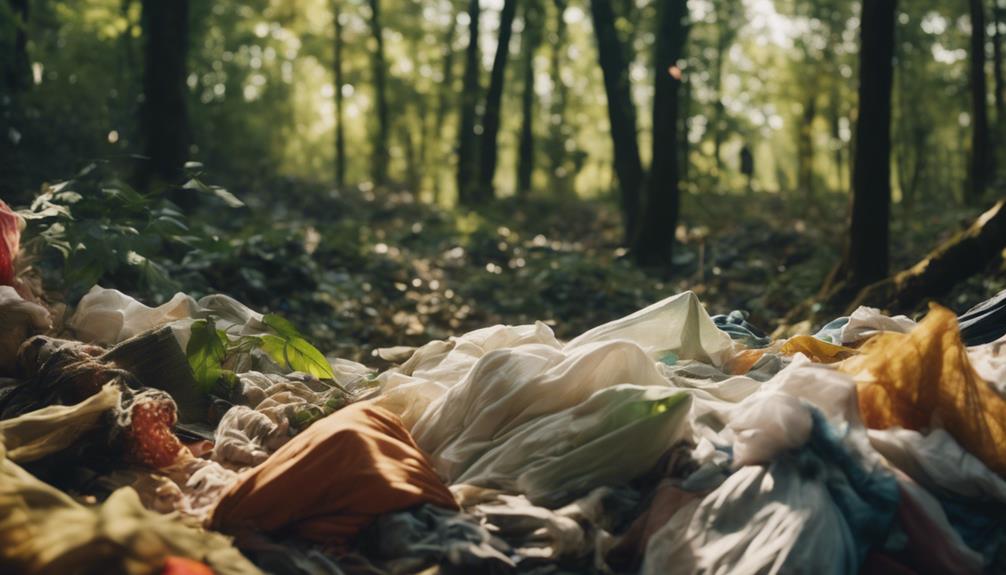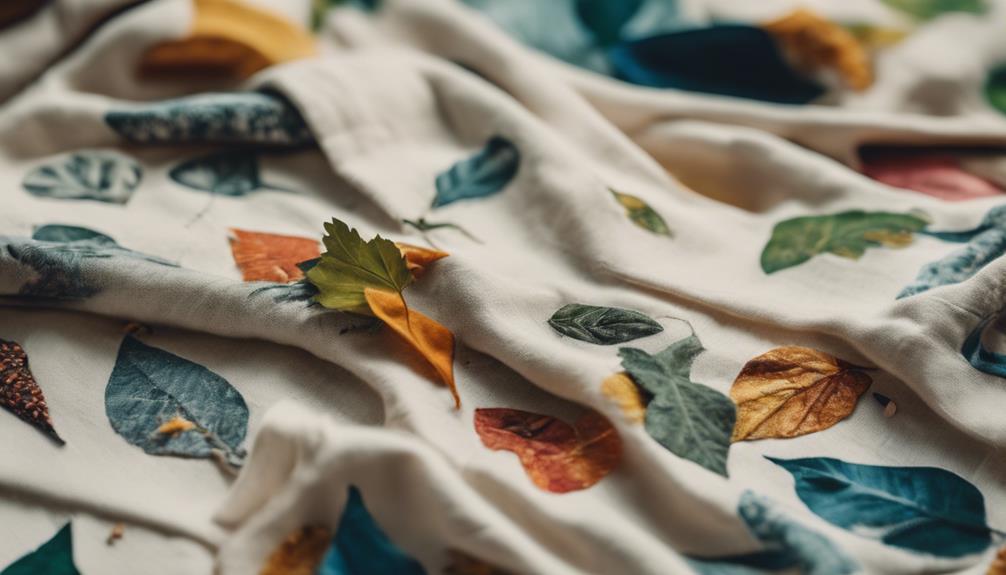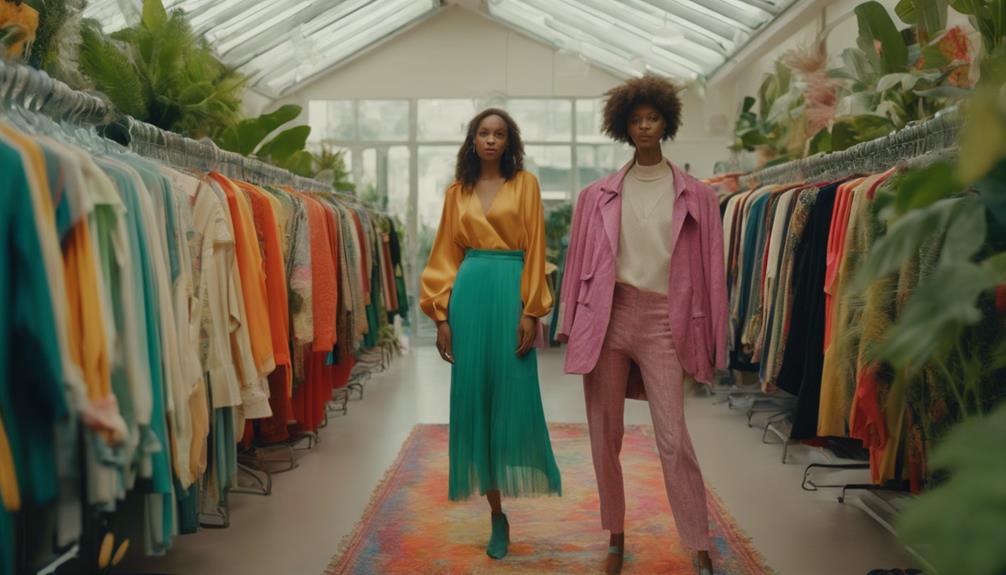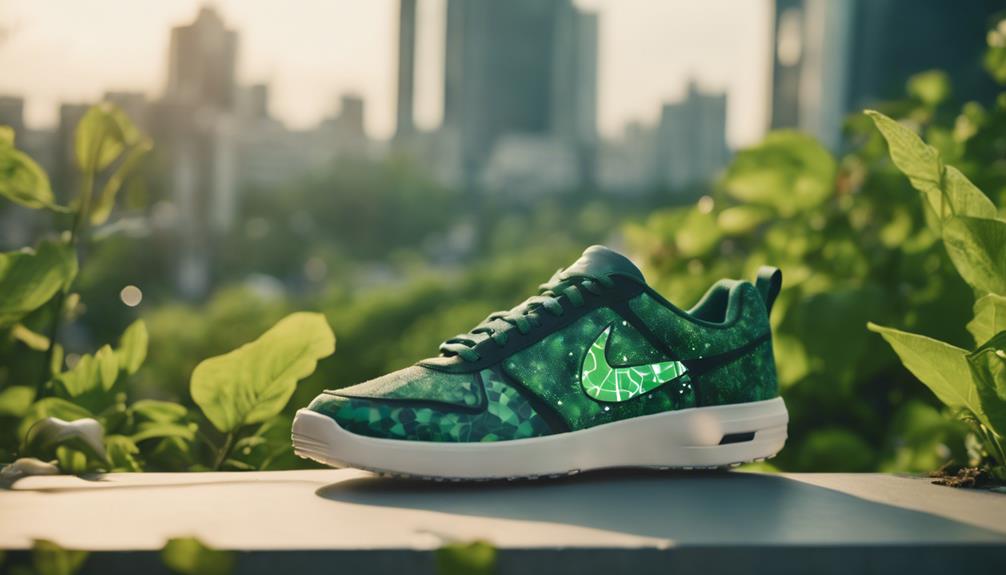Sustainable fashion isn’t always cruelty-free, and that might surprise you! While it aims to reduce environmental harm, many sustainable materials still involve synthetic components derived from fossil fuels. Vegan fashion can help eliminate animal cruelty, but it often relies on materials that contribute to pollution and microplastics. You’ll also find that not every brand is transparent about their practices, leading to confusion on what’s genuinely ethical. So, if you think sustainable equals cruelty-free, you might need to rethink that. Discovering the nuances behind these terms can empower you to make more informed choices moving forward.
Key Takeaways
- Sustainable fashion aims to reduce environmental harm but not all sustainable materials are cruelty-free, as some may still involve animal-derived components.
- Vegan materials often rely on synthetic fibers, which can contribute to pollution and microplastic issues, complicating the cruelty-free label.
- Transparency in brand practices is crucial; many brands mislead consumers with greenwashing, leading to misconceptions about sustainability and cruelty-free claims.
- Innovations like plant-based leathers can be more sustainable, yet they may still include harmful additives, raising questions about true eco-friendliness.
Understanding Sustainable Fashion
Sustainable fashion aims to reduce environmental harm by using eco-friendly materials and ensuring ethical labor practices throughout the supply chain. This approach directly contrasts with fast fashion, which contributes to significant pollution and waste.
When you choose sustainable fashion, you're not just making a stylish choice; you're supporting practices that minimize the use of new resources. Did you know that about 97% of clothing production relies on new resources? By opting for sustainable fabrics like organic cotton or recycled fibers, you help conserve natural resources and reduce landfill waste.
Moreover, the global fashion industry generates a staggering 92 million tons of waste annually, accounting for 4% of global waste. Embracing sustainable fashion can mitigate this crisis.
It's also essential to reflect on animal welfare in this situation. Sustainable fashion often means selecting materials that are ethically sourced and don't harm animals, ensuring a more compassionate approach to your wardrobe.
As consumer demand for sustainability grows, with over 50% of shoppers expected to prioritize eco-friendly practices, your choices can contribute to a positive change in the industry. Choosing sustainable fashion isn't just a trend; it's a commitment to a better future.
The Complexity of Cruelty-Free

Choosing cruelty-free options in fashion can be just as complex as selecting sustainable materials, as the implications of these choices often extend beyond animal welfare.
You might think vegan leather is a perfect alternative, but many products labeled as cruelty-free use synthetic materials like PU and PVC, which come from non-renewable fossil fuels. These materials can lead to significant environmental impact, including pollution and harm to ecosystems.
While it's great to prioritize animal welfare, ethical concerns don't stop there. The production of these vegan materials often involves toxic chemicals, putting not only the environment but also the health of workers at risk. So, even if a product claims to be cruelty-free, it can still fall short of ethical standards.
This complexity highlights the importance of educating yourself on the environmental and ethical implications of your choices. Transparency in brand practices is essential to avoid falling for greenwashing tactics.
When you make informed decisions, you can better navigate the intricate landscape of cruelty-free fashion and truly align your values with your purchases.
Environmental Impact of Materials

When you choose materials for your wardrobe, it's essential to take into account their environmental impact.
While many brands promote vegan options as eco-friendly, not all materials are created equal, and some may still harm the planet.
Eco-Friendly Material Choices
The environmental impact of materials used in fashion can greatly influence your choices and the industry's overall sustainability. While many brands market their products as eco-friendly, it's crucial to dig deeper.
Vegan leather, for instance, often contains synthetic fibres like polyurethane (PU) and polyvinyl chloride (PVC), which are derived from non-renewable fossil fuels. These materials can harm ecosystems and contribute to pollution.
You might think plant-based options like fruit or cactus leather are better choices, but they can still be coated with those same harmful plastics, undermining their sustainability claims. Plus, microplastics, which pose health risks and environmental concerns, are prevalent in both animal-derived and vegan products due to the plastics used in their production.
Though some bio-based alternatives are emerging, the lack of transparency in marketing can lead to misleading claims about the eco-friendliness of these materials. The industry still needs to focus on developing truly petrochemical-free options.
Impact of Animal Products
Understanding the impact of animal products on the environment is just as important as evaluating the materials used in fashion. The leather industry plays a significant role here, as it's responsible for the slaughter of over 430 million animals each year. This mass production contributes heavily to greenhouse gas emissions, with cattle rearing alone accounting for about 14.5% of global emissions.
Moreover, livestock farming often leads to deforestation, particularly in essential ecosystems like the Amazon rainforest. Traditional leather production also involves chemical-intensive tanning processes that can pollute local water sources, posing health risks for workers and surrounding communities.
While vegan leather options exist, many are made from plastics like PU and PVC, which are derived from fossil fuels. These materials can further harm ecosystems due to microplastic pollution. Although alternative materials like Mylo and Vegea emerge as more sustainable choices, they still sometimes include synthetic binders, complicating their overall environmental impact.
In considering sustainable fashion, it's important to weigh the environmental toll of animal products and seek out truly eco-friendly alternatives.
Innovations in Alternatives
Recent advancements in sustainable materials are reshaping the landscape of vegan leather, offering alternatives that aim to minimize environmental harm while still delivering durability and style. Innovations in this field include bio-based materials like fruit and cactus leather, which attempt to reduce reliance on fossil fuels. However, many of these options are still coated with synthetic materials such as PU or PVC, complicating their sustainability claims.
You might be surprised to learn that the production of vegan leather often involves microplastics, which not only threaten our health but also contribute to widespread environmental pollution. Transparency in the supply chain is another critical issue; misleading marketing can make it tough for you to understand the true environmental impact of these products.
While the industry is making strides towards petrochemical-free options, challenges remain in achieving a fully circular economy. You need to stay informed about these innovations to make conscious choices that align with your values.
As consumers demand more sustainable options, the pressure is on brands to develop truly eco-friendly materials without harmful additives.
Animal Welfare Considerations

When you consider sustainable fashion, it's essential to think about how animal welfare plays into your choices.
By exploring ethical material sourcing and alternative leather innovations, you can greatly reduce the impact of animal products in your wardrobe.
Understanding these aspects can help you make more informed decisions that align with your values.
Ethical Material Sourcing
Sustainable fashion brands increasingly prioritize ethical material sourcing to guarantee animal welfare and reduce environmental impact. By choosing materials like organic cotton, linen, and hemp, these brands avoid animal exploitation while supporting practices that benefit the planet. The leather industry's staggering impact—slaughtering over 430 million animals annually—has prompted a movement toward cruelty-free alternatives. You might find options like pineapple leather and ocean trash polyester as more responsible choices.
However, not all vegan products are automatically cruelty-free. Many vegan leather alternatives contain plastics derived from fossil fuels, raising concerns about their overall sustainability. To truly embrace ethical material sourcing, you'll want to look for brands that commit to responsible practices, such as using recycled fibers or plant-based materials that don't harm animals.
Transparency in material sourcing is essential. It helps you identify genuinely sustainable practices and avoid misleading marketing claims. As you explore sustainable fashion, keep these considerations in mind. By choosing brands that prioritize animal welfare and ethical material sourcing, you can make a positive impact on both the environment and the lives of animals.
Alternative Leather Innovations
Alternative leather innovations are revolutionizing the fashion industry by providing cruelty-free options that protect animal welfare and reduce environmental harm. With over 430 million animals slaughtered annually for leather, the shift to animal-free alternatives isn't just ethical; it's necessary.
Materials like Mylo, made from mushroom roots, and Vegea, derived from grape waste, repurpose agricultural by-products, minimizing reliance on traditional animal-derived materials.
Lab-grown leather, developed by companies like VitroLabs Inc., offers another option, using cow cells to create animal-free leather. However, scaling this production remains a challenge. While many vegan leathers are made from plastics like PU and PVC, they can still harm ecosystems and contribute to microplastic pollution, complicating the sustainability narrative.
Fortunately, the rise of plant-based materials, such as recycled cotton and hemp, enhances cruelty-free fashion alternatives. These innovations emphasize the importance of transparency in material sourcing and environmental impact, allowing you to make more informed choices.
Impact of Animal Products
Animal welfare concerns arise prominently in the fashion industry, particularly due to the harsh realities of animal product production. The leather industry alone is responsible for the slaughter of over 430 million animals annually, raising serious ethical questions.
While many brands promote vegan fashion options, beware: some of these alternatives are made from synthetic materials derived from non-renewable resources, posing their own environmental challenges.
When it comes to wool, ethical issues like mulesing inflict distress and pain on sheep, prompting many consumers to seek more humane options. This is where sustainable brands come into play. They prioritize animal welfare by sourcing innovative materials like pineapple leather, which repurposes agricultural waste, effectively reducing reliance on animal-derived products.
The shift towards animal-free materials is driven by your growing awareness of the ethical implications behind traditional animal farming and production practices. By choosing sustainable brands, you support a movement that values both animal welfare and environmental sustainability.
It's clear: opting for cruelty-free fashion isn't just a trend; it's a conscious choice that aligns with your values. In addition to supporting ethical treatment of animals, choosing cruelty-free fashion also aligns with the values of sustainability and environmental responsibility. Sustainable fashion benefits not only the planet, but also the people who work in the fashion industry, as it promotes fair labor practices and reduces the industry’s carbon footprint. By opting for cruelty-free and sustainable fashion, you are making a positive impact on the industry and the world around you.
The Role of Vegan Fashion

How can vegan fashion reshape the industry while still addressing environmental concerns?
While vegan fashion aims to eliminate animal cruelty, it often relies on synthetic materials like PU, TPU, and PVC. These materials are derived from fossil fuels and can have detrimental environmental impacts. You might find yourself paying a premium for vegan leather products, yet many of these alternatives don't offer added ecological benefits.
It's essential to recognize that not all vegan products are sustainable. Some vegan leathers still contain harmful plastics, contributing to microplastic pollution and posing health risks.
Although innovations in plant-based materials, such as fruit and cactus leather, are emerging, many still require coatings of synthetic materials for durability.
Therefore, the distinction between 'vegan' and 'sustainable' is critical. If you're committed to eco-friendly choices, look for transparency in marketing and material sourcing.
By understanding these nuances, you can make informed decisions that not only align with your values but also support truly sustainable fashion.
Embracing vegan fashion can be part of a larger movement towards responsible consumption, but it requires careful consideration of the materials involved.
Innovations in Sustainable Materials

Exploring innovations in sustainable materials reveals exciting options that can transform the fashion industry while prioritizing eco-friendliness. You'll discover alternatives that not only reduce reliance on animal products but also minimize environmental impact. These sustainable materials are paving the way for a more compassionate and responsible fashion future.
Here are some significant innovations you should know about:
- Mylo: A lab-grown leather derived from mushroom roots, offering an eco-friendly alternative to traditional leather.
- Orange Fiber: Made from byproducts of the orange juice industry, this material provides a sustainable silk alternative while utilizing agricultural waste.
The rise of bio-fabricated materials, like spider silk created through fermentation processes, showcases the potential for reducing the ecological footprint of fashion.
Brands like PANGAIA are also exploring grape leather and other eco-friendly materials, continuously pushing the boundaries of what sustainable fashion can achieve.
Consumer Perception and Misconceptions

Understanding the innovations in sustainable materials is only part of the equation; consumer perception and misconceptions about these products play a significant role in shaping the future of sustainable fashion. Many people mistakenly equate vegan fashion with sustainability, not realizing that some vegan materials can harm the environment. This confusion is often fueled by greenwashing, where brands misrepresent their products as eco-friendly.
Here's a visual representation of some common misconceptions and facts:
| Misconceptions | Facts |
|---|---|
| Vegan equals sustainable | Not all vegan products are environmentally friendly; many use fossil fuels. |
| Vegan leather is always eco-friendly | Some vegan leathers are made from harmful plastics. |
| Sustainable fashion is easy to identify | Greenwashing complicates the decision-making process. |
| Animal welfare means low environmental impact | Animal welfare and environmental impact are complex and interrelated. |
As you navigate the world of sustainable fashion, understanding these perceptions and misconceptions will help you make informed choices. Your awareness can drive demand for genuine sustainable practices, encouraging brands to adopt transparency and authenticity in their offerings.
Ethical Practices in Fashion

Ethical practices in fashion are essential for ensuring workers receive fair wages and work in safe conditions, directly influencing the industry's impact on communities and the environment. By supporting fashion brands that prioritize these practices, you contribute to a more humane and sustainable industry.
Consider the following aspects of ethical practices:
- Transparency: Eco-ethical brands often disclose their supply chains, helping you make informed choices about where your clothes come from.
- Fair Labor: Many brands collaborate with certified factories that adhere to strict ethical standards, ensuring fair wages and safe working conditions for workers.
As a conscious consumer, your purchasing decisions can drive demand for ethical practices in fashion. Documentaries and awareness campaigns have shed light on social injustices, empowering you to support brands that align with your values.
Strategies for Conscious Shopping

When you're shopping for clothes, it's essential to research brands' sustainability claims and ethical practices.
Consider opting for second-hand items, which can save you money while reducing waste.
Research Brand Practices
Researching brand practices is essential for making conscious shopping choices in sustainable fashion. By digging into how brands operate, you can guarantee your purchases align with your values, particularly when it comes to cruelty-free options. Start by looking for certifications like Fair Trade or the Global Organic Textile Standard (GOTS) that indicate a brand's commitment to ethical labor and sustainability.
Consider these key strategies:
- Check for transparency: Brands like Stella McCartney and TOMS openly share information about their supply chains, making it easier for you to understand their practices.
- Explore alternative materials: Investigate whether a brand uses plant-based leathers or recycled fibers, which can lessen dependence on animal products and reduce environmental impact.
Opt for Second-Hand
Opting for second-hand clothing not only helps you save money but also considerably reduces your environmental footprint. By choosing second-hand, you contribute to sustainable fashion and combat the staggering 92 million tons of waste generated by the industry each year. Every time you buy reused clothing, you save approximately 27 kg of CO2 emissions compared to purchasing new garments, making a significant impact on the planet.
Moreover, thrift store shoppers save an average of $1,760 annually, proving that second-hand shopping is a cost-effective alternative to fast fashion. You'll find unique styles and high-quality materials that allow you to express your individuality while promoting sustainability. Engaging with resale and vintage markets also supports local economies, as many thrift shops reinvest in their communities.
Incorporating second-hand pieces into your wardrobe not only benefits your wallet but also aligns with a more conscious and responsible lifestyle. By embracing second-hand fashion, you become part of a growing movement aimed at minimizing environmental impact and fostering a more sustainable future.
Prioritize Quality Over Quantity
Prioritizing quality over quantity in your wardrobe helps you make conscious choices that benefit both your style and the planet. By investing in durable garments, you not only reduce waste but also step away from the fast fashion industry's relentless cycle.
Research shows that consumers buy 60% more clothing than in 2000, further harming our environment. Instead, focus on high-quality items that utilize sustainable materials, like organic cotton or recycled fibers, which have a lower environmental impact.
Here are a few strategies to help you prioritize quality:
- Choose brands that prioritize ethical labor practices: Support companies that are transparent about their supply chains.
- Invest in timeless pieces: Select items that won't go out of style and can be worn for years.
The Future of Sustainable Fashion

The future of sustainable fashion is set to revolutionize the industry through innovative materials and practices that prioritize both environmental responsibility and animal welfare. You'll notice a significant shift towards alternative materials like lab-grown leather and plant-based fibers. These advancements not only cater to your desire for cruelty-free options but also drastically reduce the environmental impact of traditional fashion production.
By 2025, it's expected that over 50% of global shoppers, including you, will actively seek eco-friendly fashion. This demand will push brands to adopt transparent practices in their supply chains, ensuring you know where and how your clothes are made. The sustainable fashion market is projected to reach $8.25 billion, underscoring the commitment to ethical production and a decrease in animal-derived materials.
Moreover, regenerative practices, including carbon-negative wool and mushroom-based leathers, show a promising trend towards a fashion industry that values both animal welfare and ecological health. Embracing circular economy principles like upcycling and recycling will likely become standard, reducing waste and promoting resource conservation for future generations.
The future is bright for sustainable fashion, and you can be part of it!
Frequently Asked Questions
Do People Really Care About Sustainable Fashion?
Yes, people really care about sustainable fashion. You're not alone; many college students and younger consumers prioritize eco-friendly choices. Social media's influence is driving this trend, encouraging a shift towards responsible shopping habits.
What Is the Problem With Sustainable Fashion?
Sustainable fashion's like a double-edged sword; while it aims to protect our planet, it can harm ecosystems with synthetic materials. You need to scrutinize brands to uncover the hidden costs of their so-called sustainability.
How Is Sustainable Fashion Ethical?
Sustainable fashion's ethical because it prioritizes fair labor practices, supports local economies, and encourages transparency in supply chains. By choosing eco-conscious brands, you promote humane working conditions and help reduce environmental impact through responsible consumption.
How Does Sustainable Fashion Save Animals?
You know what they say: every little bit helps. By choosing sustainable fashion, you're reducing animal suffering, supporting cruelty-free materials, and encouraging brands to innovate while promoting ethical practices that protect our furry friends.
Conclusion
In summary, steering through the world of sustainable fashion can feel like unraveling a never-ending puzzle, but it's worth it!
By understanding the nuances of cruelty-free practices and making conscious choices, you're not just dressing yourself; you're shaping the future of the planet.
Remember, every small step you take makes a massive impact.
So, embrace ethical fashion and become a part of this vibrant movement—your wardrobe and the world will thank you!









